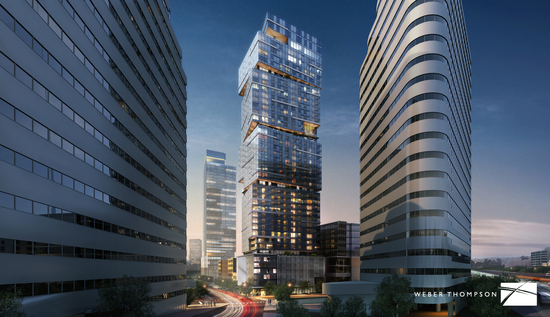|
Subscribe / Renew |
|
|
Contact Us |
|
| ► Subscribe to our Free Weekly Newsletter | |
| home | Welcome, sign in or click here to subscribe. | login |
Architecture & Engineering
| |
 |
October 3, 2019
Survey: Weber Thompson

Specialty: Full-service design firm specializing in architecture, landscape architecture and interior design.
Management: Blaine Weber, Kristen Scott, Jeff Reibman, Amanda Keating and Elizabeth Holland.
Founded: 1988
Headquarters: Seattle
2018 revenues: $14.7 million
Projected 2019 revenues: $15 million
Projects: Living Stone office building, Seattle; Orenda at Othello Square, Seattle; Nexus condominium tower, Seattle
Weber Thompson’s Kristen Scott, Jeffrey Reibman, Blaine J. Weber and Amanda Keating answered questions about their firm and the industry.
Q: Does sustainability still play a key role in your designs? What are some new advances or technologies you’ve employed?
Kristen Scott: Sustainable design practices are deeply embedded in our approach to design. Every day there are new programs in development driving the adoption of these practices.
For example, we currently have several Living Building Pilot office projects. These projects are required to meet deeply reduced energy and water usage requirements that are measured post occupancy in addition to achieving Petal Certification through the International Living Future Institute. Meeting these requirements requires new technologies and creative thinking!
We are collaborating early in the design process in a variety of ways, from biophilic design charrettes to advanced modeling and analysis with our consultants, all of which influence the direction of our design solution.
Several of our newest projects are utilizing mass timber for their structural systems. In a typical five- to seven-story office building, mass timber can be left exposed, allowing everyone to reap the benefit of the beauty of a natural material as well as providing significantly reduced embodied carbon over other traditional structural systems.
New materials and technologies are a necessity if we are going to significantly reduce the impacts of new construction on climate change.
Q: Do you expect the hospitality sector will continue to be strong?
Jeffrey Reibman: Seattle already ranks among the most underserved markets in terms of hotel demand. With the convention center expansion and our strong economy, we expect that demand will only increase and hospitality will be a strong market for some time.
We’re especially excited to see really innovative hotel providers working to meet a changing market with products targeted at younger travelers. As hotels expand in both quantity and variety here in Seattle we’re hopeful that the hospitality industry can take back some of the market share lost to short-term rentals.
Q: What has Nexus tower meant for the firm’s design reputation?
Blaine J. Weber: It was a rare treat when Christian Chan of Burrard Development (our client for the Nexus tower project) asked that we design a deliberately iconic and cutting-edge residential tower that would be both sculptural and playful.
Of course, this invitation to innovate and “break out of the box” also came with the proviso to stay within a reasonable budget. During early design exploration, we landed on an idea to break the tower into a series of smaller cubes that would twist four degrees in opposite directions — for a total of eight degrees of separation. This subtle shift allows for a conventional tower structure whereby all structure remains in vertical alignment, in spite of the twisting.
Weber Thompson is committed to elevating the quality of our design game with each and every project, but we have to give credit to our client for opening the door to iconic innovation on this project.
Q: Are there any new sectors the firm has entered recently that show promise?
Amanda Keating: We’re currently working on our third student-targeted housing project in (or near) the U District, and it’s very fun! Our deep portfolio of experience designing in a wide variety of multifamily housing types has translated seamlessly to the student realm, and in fact, has brought a new way of thinking to our broader market-rate multifamily projects.
The issue of housing affordability in our urban area is not lost on us or our clients, and we’re now exploring the concept of co-living in a handful of projects.
Other Stories:
- Why electric scooters could be a game changer for Seattle
- CLT: construction’s lean, green beauty queen
- The AEC industry has a data problem
- What our evolving mobility options mean for designers and developers
- New OSU-Cascades academic building will aim for net zero
- Mass timber is bringing the warmth of wood to the workplace
- With so many tech advances, why has AEC productivity growth stalled?
- Survey: Cary Kopczynski & Co.
- Survey: Johnston Architects
- Survey: Bohlin Cywinski Jackson
- These 3 Northwest projects show how listening to clients pays off
- Which project delivery methods work best?
- How understanding building codes can help you get more out of your project
- How successful workplaces offer more than just a place to work


